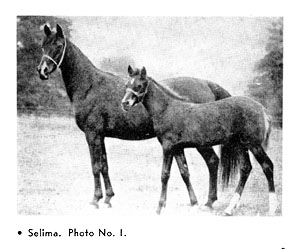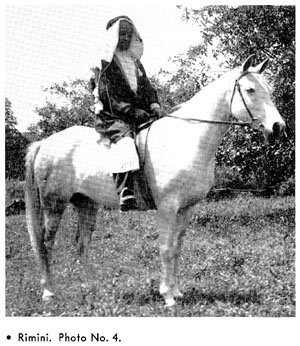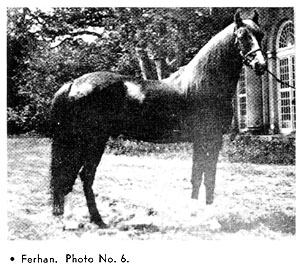![]()
|
Reading Raswan |
|
|
![]()
|
|
| THE "KEY" HORSES to the study of Arabians are the following
animals whose pedigrees I shall analyze. I selected these individuals because
their photos and pedigrees can be checked in stud books and various books
concerning horse breeding and the history of Arabian and Thoroughbred horses.
They are all double-registered and therefore can be looked up in Thoroughbred
records, too.
Any strain is liable to represent in its various individuals different types, if these particular horses are descendants of mixed strains. In other words, an Arabian horse does not represent the type and strain under which it is registered if it is a mixture of various strains. A Scotch collie ceases to have pure collies if she has been mixed with a bulldog or a greyhound, but her puppies still belong to the genus "dogs." |

|
LET US take the pictures and pedigrees of Selima
(photo 1) and Silverfire (photo 2). Both are Hamdaniyah mares and registered
as such, but they are as unlike as a bulldog and collie. Silverfire is
a mare of stocky build and Selima the opposite type. Both have only one
line of Hamdani blood (one-sixteenth Hamdani blood in their fourth generation),
but the heavy built mare Silverfire has sire and both her sire's parents
at Kuhaylan (masculine) strain, while Selima has both sire and nine other
grand and great grand parents of the feminine Saqlawi (and related) strains
and not one Kuhaylan (masculine) ancestor among them. If we speak of authentic
(Asil-pure) strains, we cannot call horses like Selima and Silverfire as
belonging to the same (Hamdani) strain. Of course they will be unlike in
type, because they have entirely different pedigrees.
SILVERFIRE AND Selima are outstanding examples for the serious study of Arabian pedigrees of mixed strains. THE MUNIQI mare Fasiha (photo 3) is another striking example of wrong strain breeding. Fasiha looks heavy with a plain head (straight profile of face and small eyes), the result of crossing a Muniqiyah mare with a masculine Kuhaylan stallion. Fasiha and Silverfire look very much alike in shape (though one is registered as a Muniqiyah and the other, Silverfire, a Hamdaniyah) because both are predominantly of Kuhaylan (and related) strains. Their heads are different: Silverfire is five generations removed from Muniqi, while Fasiha carries Muniqi blood right along on her mother's side, but Fasiha by pedigree is not a Muniqiyah; she is seven-eighths of other blood and therefore does not represent the Muniqi type. |
| THERE ARE hundreds of similar cases -- some even are such extreme cases that an Arabian horse may be almost a pure-bred type of an entirely different strain than the one it has been registered under. In Arabians of mixed strains only that strain counts which predominates (and not the one under which the animal has been registered in the stud book). See the pedigree of the following horses: Nissar and Naufal, both Kuhaylan, both different shape. Naufal had Abayyan and Muniqi blood added. Compare also Proximo and Kibla. Kibla was without any Muniqi (only Kuhaylan and Saqlawi blood lines). A beautiful, well-balanced mare with a perfect head. Proximo was high-legged with a plain head and a straight profile from his Muniqi sire. |

|
FOR A STRIKING example we may consider a photo
which has been distributed widely and shows six handsome white Arabian
mares: Slipper, Rimini (photo 4), Rose of France, Kiyama, Rifala and Kareyma
(photo 5). I happen to know all of them and their individual photographs
can be found in catalogues and stud books. These six mares look very much
alike in one group, as they are all Kuhaylat except Slipper, a Saqlawiyah,
but who has overwhelmingly Muniqi, Hamdani and Kuhaylan blood. Rimini is
five-eighths Kuhaylan, also Rose of France. Three-quarters Kuhaylan are
kareyma and Kiyama, and half Saqlawi (though on the dam's side Kuhaylah)
is Rifala, who should be the most refined and handsome of all six.
YES, IT IS possible to "read" the strain of an Arabian if one has a knowledge of the characteristics of the strains, which is not difficult, as these strains "come down" to the three types which I have mentioned and explained in my articles: Strength, Beauty (refinement), Speed (angular, long, somewhat coarser). Arabs of mixed strains are harder to read, some almost impossible to decipher, but as long as the bloodline of one strain predominates it can be picked out quite easily. |
| IN A LATER article I will prove from photographs
and pedigrees of registered Arabians the reappearance of characteristics
and their disappearance - depending on the number of generations an individual
horse is removed from a certain strain. It sounds difficult, but it is
as simple and easy as the theory of the three types (strength, beauty and
speed) and the photographs make it convenient to explain.
NOW TO the rest of the "key" horses necessary to the understanding of strains: There are some Muniqi Arabians who are so surprisingly good looking or so well rounded that they could pass for Saqlawiyat or Kuhaylat. The Muniqi are angular, long, somewhat coarse and -- here we have Faris, a registered Muniqi, but handsome, with rounded outlines, not coarse at all. Why? |
 |
THE PEDIGREE gives the answer: Faris is only one-eighth Muniqi, but three-eighths (one-half) Kuhaylan and the rest Saqlawi and related blood (Abayyan and Dahman). Ferhan should be more powerful, muscular than Faris, as Ferhan has more Kuhaylan (strength) blood. I hope he is stronger than Faris (I have seen neither him nor Faris) but I would call neither Ferhan nor Faris "examples" of the Muniqi strain, but rather most striking models of mixed strain breeding and good horses because of the overwhelming infusion of Kuhaylan and Saqlawi blood, which became predominant on both horses. |
| I HAVE BEEN asked to reveal the names of those
double-registered Arabian sires and broodmares who represent the Kuhaylan
and Saqlawi type.
APPARENTLY I have been asked about double registered Arabians only because we have complete pedigree records of single registered Arabians in our American stud books of the Arabian Club, but records of most double registered Arabians (especially the early ones) are not available to most breeders in America. THE STUDY of pedigrees of Arabian horses has been my life's work and I have these pedigrees on hand. They can be bought through the Jockey Club or Weatherby in England. TO ANSWER the two above questions I want ot say: No. 1 representing Kuhaylan -- Strength type in conformation and pedigree are: Skowronek, Raffles, Grey Owl, Rakhta, Hamida, Indaia, Mahrusa, Nusara, Raseyn, Indra, Naseem, Rissletta, Ridaa, Ronek (an outstanding example of masculine strength, though a registered Saqlawi. His pedigree proves that he is overwhelmingly a Kuhaylan), Rossana, Roxana, Hagar, Radi, Selfra.
I MIGHT ADD , the best combination type of Kuhaylan and Saqlawi (without Muniqi ever) were: Rasim, Raseem (though Rasim was the better horse. Rasim had no trace of Muniqi blood in his pedigree), Kibla, Mesaoud, Daoud, Ibn Yashmak, Iram, Negma, Waziri, Mirage, Ghazala, Risala (no trace of Muniqi blood; this most wonderfully balanced mare produced Rasim, Rijma, and Rissla), Rifala, Rifla, Rasima, Nasra, Feysul. [Many of these are pictured at the CMK site] PURE-STRAIN breeding is not a theory, but it has been established on a foundation which others have laid long before me -- the Bedouins themselves -- and it was recognized by Prince Faysul, Abbas Pasha, Ali Pasha Sherif (not to be confused with Blunt's Ali Pasha of Deyr Ex-Zor.) and Sir Wilfred and Lady Anne Blunt. I CANNOT CLAIM greater authority than the source from which I gathered my information, the Bedouins in Arabia: the Mutayr, Ajman, Atayban, Ruala, Shammar and fourteen other tribes. Sheykh Faysul Ibn Dauwish (Mutayr), Sheykh Ibn Hegna (Atayban), Shiyukhs Khalid, Nuri and Sattam Sha'lan of the Ruala, Sheykh Rakan of the Saba', Sheykh Mijem Ibn Meheyed of the Fid'an, Sheykh Sa'dun of the Muntifiq, Sheykh Muhammad Ibn Khalifa of Bahreyn, and many other authorities and breeders of Arabian horses, were personal friends, among whom I have spent twenty-five years in search an and study of fine horses. These men bear evidence and are qualified to pronounce judgment on breeding and history of Arabian horses in the desert -- and they believe in the pure-breeding of the strains. FROM THESE Shiyukhs and their forefathers have come all the ancestors of the best Arabian horses in Europe and America. COULD IT BE an "accident" that Gulnare, Rizvan, Ibn Mahruss, Abuzeyd, Wazir, Mesaoud, Rasim, Naseem, Naziri, Nasik and a host of others were of outstanding classic (antique) type because they never traced to any Muniqi blood? Was it an 'accident" that Kismet and Maidan were the fastest racing Arabs known because they were pure Muniqi? Was it an "accident" that the Darley Arabian, the sire of Flying Childers was a Muniqi, and the Godolphin Arabian of a Muniqi related strain, the Jilfan? |
|
Davenports: Articles of History Arabian Visions' |
This page hosted by ![]()
Get your own Free Home Page